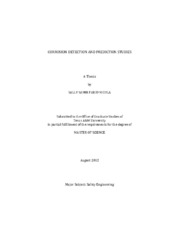| dc.contributor.advisor | Mannan, M. S. | |
| dc.creator | Nicola, Sally | |
| dc.date.accessioned | 2012-10-19T15:30:09Z | |
| dc.date.accessioned | 2012-10-22T18:04:22Z | |
| dc.date.available | 2014-11-03T19:49:15Z | |
| dc.date.created | 2012-08 | |
| dc.date.issued | 2012-10-19 | |
| dc.date.submitted | August 2012 | |
| dc.identifier.uri | https://hdl.handle.net/1969.1/ETD-TAMU-2012-08-11544 | |
| dc.description.abstract | Corrosion is the most important mechanical integrity issues the petrochemical industry has to deal with. While significant research has been dedicated to studying corrosion, it is still the leading cause of pipeline failure in the oil and gas industry. Not only is it the main contributor to maintenance costs, but also it accounts for about 15-20% of releases from the petrochemical industry and 80% of pipeline leaks. Enormous costs are directed towards fixing corrosion in facilities across the globe every year. Corrosion has caused some of the worst incidents in the history of the industry and is still causing more incidents every year. This shows that the problem is still not clearly understood, and that the methods that are being used to control it are not sufficient.
A number of methods to detect corrosion exist; however, each one of them has shortcomings that make them inapplicable in some conditions, or generally, not accurate enough. This work focuses on studying a new method to detect corrosion under insulation. This method needs to overcome at least some of the shortcomings shown by the commercial methods currently used. The main method considered in this project is X-ray computed tomography. The results from this work show that X-ray computed tomography is a promising technique for corrosion under insulation detection. Not only does it detect corrosion with high resolution, but it also does not require the insulation to be removed. It also detects both internal and external corrosion simultaneously.
The second part of this research is focused on studying the behavior of erosion/corrosion through CFD. This would allow for determining the erosion/corrosion rate and when it would take place before it starts happening. Here, the operating conditions that led to erosion/corrosion (from the literature) are used on FLUENT to predict the flow hydrodynamic factors. The relationship between these factors and the rate of erosion/corrosion is studied. The results from this work show that along with the turbulence and wall shear stress, the dynamic pressure imposed by the flow on the walls also has a great effect on the erosion/corrosion rate. | en |
| dc.format.mimetype | application/pdf | |
| dc.language.iso | en_US | |
| dc.subject | Corrosion | en |
| dc.subject | Corrosion Under Insulation | en |
| dc.subject | Erosion/Corrosion | en |
| dc.subject | X-ray Computed Tomography | en |
| dc.title | Corrosion Detection and Prediction Studies | en |
| dc.type | Thesis | en |
| thesis.degree.department | Chemical Engineering | en |
| thesis.degree.discipline | Safety Engineering | en |
| thesis.degree.grantor | Texas A&M University | en |
| thesis.degree.name | Master of Science | en |
| thesis.degree.level | Masters | en |
| dc.contributor.committeeMember | Holste, James C. | |
| dc.contributor.committeeMember | Petersen, Eric L. | |
| dc.type.genre | thesis | en |
| dc.type.material | text | en |
| local.embargo.terms | 2014-10-22 | |


